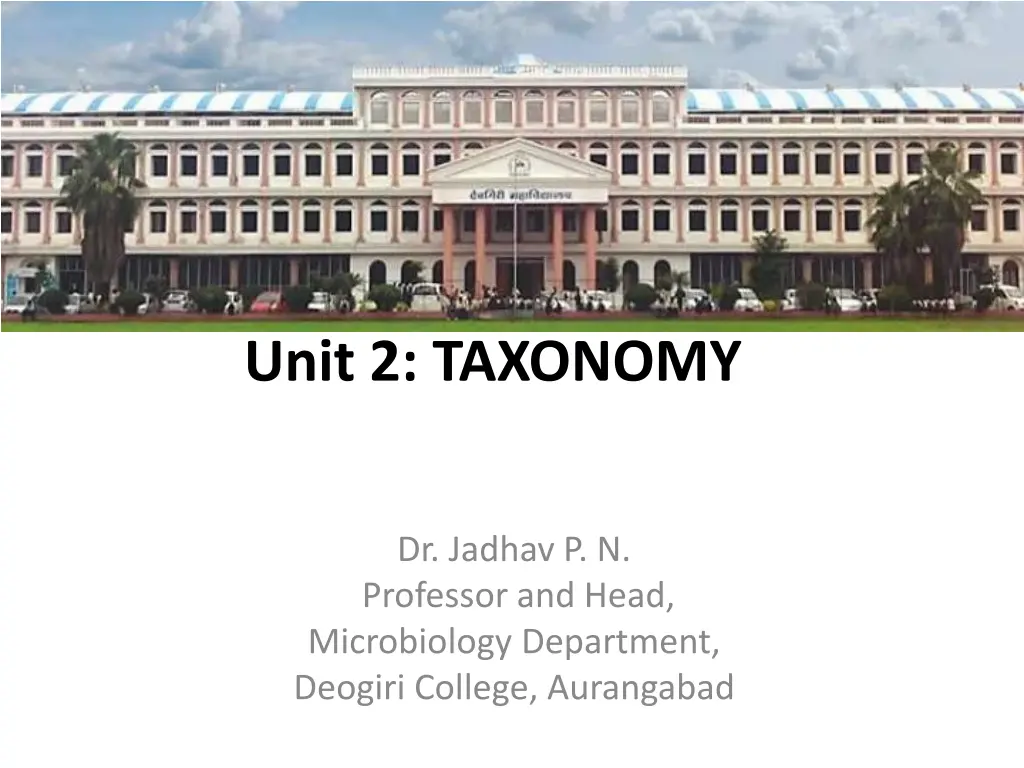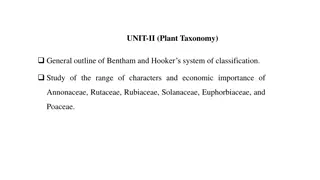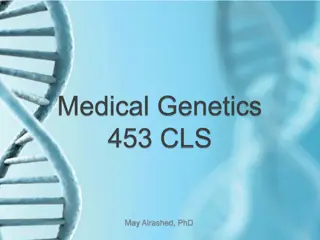
Fundamentals of Microbiology: Taxonomy and Classification Overview
Explore the essential concepts of microbial taxonomy, including physiological and metabolic characteristics, ecological characteristics, and genetic analysis. Understand how these factors contribute to the classification and identification of microorganisms in the field of microbiology.
Download Presentation

Please find below an Image/Link to download the presentation.
The content on the website is provided AS IS for your information and personal use only. It may not be sold, licensed, or shared on other websites without obtaining consent from the author. If you encounter any issues during the download, it is possible that the publisher has removed the file from their server.
You are allowed to download the files provided on this website for personal or commercial use, subject to the condition that they are used lawfully. All files are the property of their respective owners.
The content on the website is provided AS IS for your information and personal use only. It may not be sold, licensed, or shared on other websites without obtaining consent from the author.
E N D
Presentation Transcript
B. Sc. First Year Semester I Paper I Fundamentals of Microbiology Unit 2: TAXONOMY Dr. Jadhav P. N. Professor and Head, Microbiology Department, Deogiri College, Aurangabad
B. Sc. First Year Semester I Paper I Fundamentals of Microbiology Unit 2: TAXONOMY Dr. Jadhav P. N. Associate Professor and Head, Microbiology Department, Deogiri College, Aurangabad
Physiological and metabolic characteristics Some physiological and metabolic characteristics are very useful in classifying and identifying microorganisms because they are directly related to the nature and activity of microbial enzymes and transport proteins. Some most important physiological and metabolic characteristics used in microbial taxonomy are nutritional types, cell wall components, carbon and nitrogen sources, energy metabolism, osmotic tolerance, oxygen relationships, temperature relationships, salt requirements and tolerance, secondary metabolites, storage inclusions, etc.
Table: Some taxonomically useful physiological and metabolic characteristics and their variations
Ecological characteristics Ecological characteristics, i.e., the characteristics of relationship of microorganisms to their environment significantly contribute in microbial taxonomy. It is because even very closely related microorganisms may vary considerably with respect to their ecological characteristics. For convenience, microorganisms inhabiting freshwater, marine, terrestrial, and human body environments differ from one another and from those living in different environments. However, some of the most important ecological characteristics used in microbial taxonomy are - life cycle patterns - the nature of symbiotic relationship - pathogenic nature - variations in the requirements for temperature, pH, oxygen, and osmotic concentrations.
Genetic Analysis Genetic analysis is mostly used in the classification of eukaryotic microorganisms because the species is defined in these organisms in terms of sexual reproduction which occurs in them. This analysis is sometimes employed in the classification of prokaryotic microorganisms particularly those that use the processes of conjugation and transformation for gene exchange. For example, members of genus Escherichia may conjugate with the members of genera Shigella and Salmonella but not with those of genera Enterobacter and Proteus. This shows that the members of first three genera are more closely related to one another than to Enterobacter and Proteus.
Genetic Analysis Studies of transformation with genera like Bacillus, Haemophilus Micrococcus, Rhizobium, etc. reveal that transformation takes place between different bacterial species but only rarely between genera. This provides evidence of a close relationship between species since transformation tails to occur unless the genomes are very much similar. Bacterial plasmids that carry genes coding tor phenotypic traits undoubtedly contribute in microbial taxonomy as they occur in most genera.
Molecular characteristics comparison of proteins nucleic acid base composition nucleic acid hybridization nucleic acid sequencing
Comparisons of proteins determination of amino acid sequence comparison of electrophoretic mobility determination of immunological cross- reactivity comparison of enzymatic properties
Comparison of proteins The amino acid sequences of proteins are direct reflections of mRNA sequences and therefore closely related to the structures of the genes coding for their synthesis. In the light of this, the comparisons of proteins from different bacteria prove very useful taxonomically. Although there are many methods to compare proteins, the most direct approach is to determine the amino acid sequences of proteins with the same function. When the sequences of proteins of the same functions in two bacteria are similar, the bacteria possessing them are considered to be closely related. However, the sequences of cytochromes and other electron transport proteins, histones, heat-sock proteins, and a variety of enzymes have been used in taxonomic studies.
Nucleic acid base composition The GC ratio the base sequence and varies with sequence changes as follows: The GC ratio of DNA from animals and higher plants averages around 40% and ranges between 30 and 50%. Contrary to it, the GC ratio of both eukaryotic and prokaryotic microorganisms varies greatly; prokaryotic GC ratio is the most variable, ranging from around 20% to almost 80%. Despite such a wide range of variation, the GC ratio of strains within a particular species is constant.
Nucleic acid base composition (contd.) Genomic DNA GC ratios of a wide variety of microorganisms have been determined, and knowledge of this ratio can be useful in microbial taxonomy, depending on the situation. For convenience, two microorganisms can possess identical GC ratios and yet turn out to be quite unrelated both taxonomically and phylogenetically because a variety of base sequences is possible with DNA of a single base composition. In this case, the identical GC ratios are of no use with view point of microbial taxonomy. In contrast, if two microorganisms GC ratio differs by greater than about 10%, they will share few DNA sequences in common and are therefore unlikely to be closely related.
GC ratio data are valuable in microbial taxonomy in at least two following ways: (i) They can confirm a scheme of classification of microorganisms developed using other data. If microorganisms in the same taxon vary greatly in their GC ratios, the taxon deserves to be divided. (ii) GC ratio appears to be helpful in characterizing bacterial genera since the variation within a genus is usually less than 10% even though the content may vary greatly between genera. For convenience, Staphylococcus and Micrococcus are the genera of gram-positive cocci having many features in common but differing in their GC ratio by more than 10%. The former has a GC ratio of 30-38%, whereas the latter of 64-75%.
Nucleic acid hybridization Nucleic acid hybridization or genomic hybridization measures the degree of similarity between two genomes (nucleic acids) and is useful for differentiating two bacteria (microorganisms). DNA-DNA hybridization is useful to study only closely related bacteria, whereas DNA-RNA hybridization helps comparing distantly related bacteria.
Nucleic acid hybridization DNA-DNA Hybridization: Double-stranded DNA isolated from one bacterium is dissociated into single strands at appropriate temperature which are made radioactive with32P,3H, or14C. Double-stranded DNA isolated from other bacterium is dissociated into single strands which are not made radioactive. The non-radioactive single- stranded DNA molecules are first allowed to bind to a nitrocellulose filter and unbound strands are removed by washing. Now the filter with bound strands of DNA is incubated with the radioactive single-stranded DNA under optimal conditions of annealing. Annealing is an interesting feature of single-stranded DNA in which the strands, on cooling, tend to re-associate to form double-helix structure automatically. Annealing occurs optimally when the temperature is brought to about 25 C below the melting temperature (Tm) in a solution of high ionic concentration.
Figure: A schematic representation of DNA- DNA hybridization as a taxonomic tool
DNA-DNA Hybridization: DNA-DNA hybridization is a sensitive method for revealing subtle differences in the genes of two bacteria (other microbes also) and is therefore useful for differentiating closely related bacteria. DNA homology studies have been conducted on more than 10,000 bacteria belonging to about 2,000 species and several hundred genera. It has proved to be a powerful tool in solving many problems of bacterial taxonomy, particularly at species level.
DNA-RNA Hybridization: DNA-RNA hybridization helps compare, unlike DNA-DNA hybridization, distantly related bacteria (microorganisms) using radioactive ribosomal RNA (rRNA) or transfer RNA (tRNA). It becomes possible because the DNA segments (genes) transcribing rRNA and tRNA represent only a small portion of the total DNA genome and have not evolved as rapidly as most other genes encoding proteins (i.e., they are more conserved in comparison to genes encoding proteins). Among the different rRNAs, the 16S rRNA of prokaryotes and the analogous 18S rRNA of eukaryotic organisms have been found to be most suitable for comparison of their sequences is taxonomic studies. One of the major impacts of rRNA studies on taxonomy, for convenience, is the recognition of three major domains the Archaea, the Bacteria, and the Eukarya by Woese and Colleagues in 1990.
DNA- RNA Hybridization: DNA-RNA hybridization technique is similar to that employed for DNA- DNA hybridization. The filter- bound non-radioactive ssDNA is incubated with radioactive rRNA, washed, and counted. An even more accurate measurement of complementarity is obtained by finding the temperature required to dissociate and remove half the radioactive rRNA from the filter; the higher this temperature, the stronger the DNA-rRNA complex and the more similar the base sequences. However, DNA-RNA hybridization has been done with thousands of bacteria for relevation of their taxonomic relationships. Such studies were made with pure cultures of bacteria till 1997-98, but since then, techniques have been developed to recover rRNA genes directly from natural habitats. This has come to be called as community analysis of rRNA from natural bacterial community.
Nucleic acid sequencing Nucleic acid (DNA and RNA) sequencing is another molecular characteristic that helps directly compare the genomic structures. Most attention has been given to the sequencing of 5S and 16S rRNAs isolated from the 50S and 30S subunits of 70S prokaryotic ribosome, respectively. The procedure of rRNA sequencing involves the following steps: (i) rRNA is isolated from the ribosome and purified (ii) Reverse transcriptase enzyme is used to make complementary DNA (cDNA) using primers that are complementary to conserved rRNA sequences (iii) The cDNA is amplified using polymerase chain reaction (PCR) and finally (iv) The cDNA is sequenced and the rRNA sequence deduced from the results.
Bergeys manual of systematic bacteriology Detailed work containing descriptions of all procaryotic species currently identified The First Edition of Bergey s Manual of Systematic Bacteriology - primarily phenetic - cell wall characteristics play important role The Second Edition of Bergey s Manual of Systematic Bacteriology - largely phylogenetic rather than phenetic






















